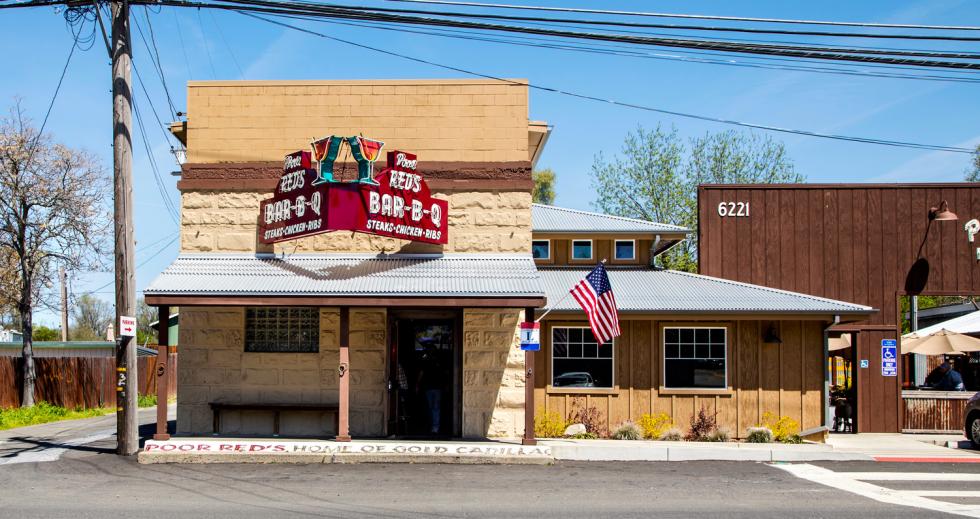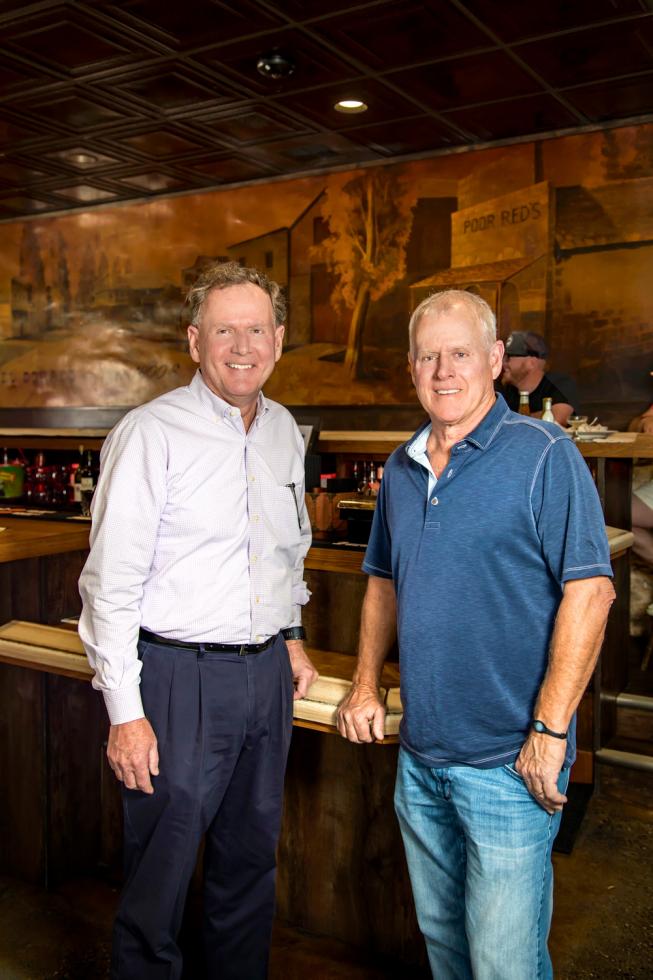When Poor Red’s shuttered its doors six years ago, it was the end of an era in the sleepy foothills town of El Dorado — or so many people thought.
But two brothers from El Dorado Hills teamed up with a veteran restaurateur to achieve one of the hardest, and often futile, feats in the industry: reopen a restaurant with success. They’ve done it by merging the storied history and famous menu of Poor Red’s — long a popular BBQ joint among locals and tourists alike — with the modern draw of a new, trendy establishment, with much-needed renovations and an expanded menu to entice more customers.
“If it had been any other place, we never would have done it. We knew it was a risk. The whole restaurant business is a risk.” Jeff Genovese, co-owner, Poor Red’s
“If it had been any other place, we never would have done it,” says Jeff Genovese, one of the owners, who like many in the Sacramento region had been making the trip to Poor Red’s since he was old enough to drink. “We knew it was a risk. The whole restaurant business is a risk.”
The risk was a big one. When Jeff and his brother Mike Genovese (partner of Sacramento financial planning firm Genovese Burford & Brothers) bought Poor Red’s four years ago, the building was in disrepair, the kitchen needed gutting, and it did not meet current building and health codes or earthquake standards. The business had 36 liens on it and was stuck in what Jeff described as a legal quagmire. In fact, their managing partner initially advised the brothers against the investment.
Poor Red’s is a gathering place for locals and tourists headed to
the mountains.

“I told them, you don’t want to be in the restaurant business. It just doesn’t pencil out,” says Mike Hountalas, who grew up in the restaurant industry, his family the operators of the famed Cliff House in San Francisco since his childhood. “I went in dragging my feet and said, ‘You guys are crazy.’”
The odds were certainly stacked against them. The list of restaurants that have opened and closed, whether by the original owners or new ones, in the Capital Region is long. And several that have attempted recent comebacks have shuttered their doors — again.
In the historic downtown of Lincoln, Beermann’s Brewery closed in 2008; it reopened in 2012 and closed again in 2013; and then reopened in 2016 and closed last year. Farrell’s Ice Cream Parlour returned its franchise to Sacramento in 2013 — which once operated four locations in the area until 1990 — but abruptly closed in 2016. The iconic Buggy Whip Restaurant and Bar in Sacramento’s Fulton Avenue district, a popular destination in the 1960s and ’70s, made it barely a year when its owners closed the doors in 2015.
Other restaurants have changed ownership, concept, name and menu in a bid to succeed at a location where their predecessors have not. Along Jackson Highway, travelers making the drive from Sacramento to the foothills have periodically seen the off-and-on-again “closed” sign hanging from the Sloughhouse Inn — an historic 1850s property not far from Davis Ranch that has had a series of owners in the last decade.
New owners Ron and Terri Gilliland, who also run Lucca and Roxy restaurants in Sacramento and Lucky Dog Ranch in Dixon, reopened the landmark restaurant under the new name Meadowlands. And in March, the owners of Celestin’s Restaurant reopened their popular Midtown restaurant in East Sacramento — its third location — after a seven-year hiatus from the business.
Maryellen Burns, author of Lost Restaurants of Sacramento and Their Recipes, says it’s incredibly difficult for any restaurant to survive: with changing consumer tastes, landlords raising rents, higher wages and a younger generation who doesn’t want to take over the family business. “Now, we have so many choices of where we can spend our money,” Burns says.
Brothers Mike (left) and Jeff Genovese renovated Poor Red’s and
expanded the menu to attract more customers.

Those choices continue to grow despite the tough work and minimal profit margins of the restaurant industry. Nationally, more than 15,145 restaurants opened between the third quarters of 2016 and 2017, according to the Bureau of Labor Statistics — a 2.5 percent increase. The industry is expanding in areas where the population is growing and the economy thriving, says Mollie O’Dell, a spokeswoman with the National Restaurant Association.
Detailed statistics don’t exist for restaurants that have reopened. But, industry experts say the recent reopening of Poor Red’s, Joe Marty’s Bar and Grille in Land Park, and the Sail Inn Grotto & Bar in West Sacramento — all in the same location with the same concept — are an anomaly. They all have something in common: All three worked to preserve the nostalgia of their former glory, but with upgraded dining spaces and menus, pulling in both their old customer base and new diners.
Walk into the door at Poor Red’s and patrons can still sit around the wood laminate high-low bar that fills the room and order the Golden Cadillac — the legendary cocktail invented there in 1952 when a newly-engaged couple visited the restaurant to celebrate.
Other traditions have remained: The heart of the menu is ribs, chicken and steak, and customers at the bar are given their change in Susan B. Anthony dollar coins. The restored murals painted in the 1940s on the bar walls depict former employees and patrons. And the building’s old stone walls — it was built as a weigh station for Wells Fargo — impress in the tiny, original dining room next to the bar.
“This place has been here a long time. It needs to stay the same,” says Jim Carlson, a loyal customer from Camino. “If they would have redone the bar, it would not have been Poor Red’s.”
But there have been changes — ones that Hountalas, who oversaw renovations at the Cliff House and at the Purple Place in El Dorado Hills, felt were critical to the bar’s success going forward.
Gone are the days when customers had to place their dinner order and sit at the bar for two hours to wait for their table. The addition of a new, bigger dining room that leads to an open-air patio has more than tripled the size of the restaurant. In the state-of-the-art kitchen, the chef makes 5-8 gallons of BBQ sauce a day and cooks the ribs on the open-fire wood grill. An expanded menu — there are now healthy options like salmon — draws a more diverse crowd for lunch.
Today, the locals also stream into Poor Red’s every Monday to see what Bloody Mary head bartender Stacy Calhoun has created, from ceviche on a tortilla to a beef sandwich on top.
The place, its owners say, is once again a gathering place for the locals in this small town of 1,400 and a stopping place for tourists making their trek to the mountains. The restaurant is making a profit, Genovese says, and is here to stay.
“If you look in any guidebook from the 1960s and on,” says Burns, “Poor Reds is the stop everybody has to stop at.”
Have you been to Poor Red’s? TWEET US @COMSTOCKSMAG




Comments
My wife and I lived up on China Hill for about 13 years back in the 90's. Loved everything about Poor Reds back then and love what the new owners have done to recapture the history and ambiance of this old watering hole. We have been back several times, the food is great and the service exceptional.
We used to live about a mile down Hwy 49 on Bonnie Lou Lane. Love the Gold Cadillacs
Be careful driving home. Not sure how I made it home....
"One" night.
Love, Poor Reds!! Been a customer 48 years. Coming from the Bay Area. Now live here so it’s a stop when friends come to town. So sad when it closed a few times. A very special place.
My first stop when I fly in. I meet my mom for a golden Cadillac. Hospitality is perfect, Foods great ... just like old times.
To say I appreciate what these owners have done to restore Poor Reds is an understatement! I have personal history in that establishment....it makes my heart happy and soul smile!